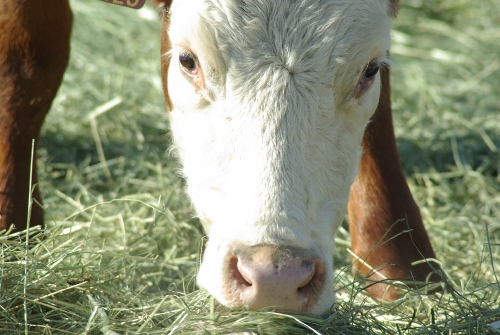I have received multiple requests to share more ranching and farming on the site. This makes me excited to hear that people are genuinely interested in agriculture. So I have teamed with my sister, Kelsy, who will be writing a monthly feed on ranch life at the Cooper Hereford Ranch. And, if you have any other requests I would love to hear them.


Cold, grey skies. Chilling north winds. Icy, treacherous roads.
This is January in Montana. Typically, at least.
Cloudless blue skies. Moderate temperatures. No wind.
This was January of 2014!

Aside from a horribly frigid cold snap in the beginning of December we Montanans have experienced an unseasonably warm January. And when I say horribly frigid I mean temperatures in the -20s for close to a week. Yes that’s finger freezing cold.
So this year’s mild month of January was great for many reasons, namely because January is the beginning of calving season. And calving is one of the most grueling and mundane times of the year. The mornings are dark and usually very frigid. The sun sets early and the work days are long and exhausting. Men work around the clock to ensure the cows are fed, calves are tended to, and barns are cleaned and strawed. Snowfall and winter weather can make for a tremendous amount of work, so decent weather is key for an uneventful calving season. So in one sense we are thankful for the mild days shared in January.
But forty degree days invoke a bit of worry in the minds of most cattlemen and farmers. Warm winters often result in dry springs and hot summers. So, although we often times become irritated when Mother Nature sends us white-outs and blizzards in January, we scowl in April when we have no moisture in the ground and our spring crops fail to sprout.
I guess we all need something to complain about, might as well be the weather!



We are fortunate to have a good crew of men that work on our ranch. THE MEN. Dad, Leroy, Dave and Donnie. The three Ds work the day shift and Leroy works the night shift. Since calving is around the clock it’s nice to have several employees to divide shifts and divvy up the workload.

A typical day in January.
3:15 am – Leroy ends the night shift between 3:00 and 3:30 am. Dad quietly slips out of bed, dresses, grabs his flash flight and walks down the hill to the calving barns. He patrols the grounds for any newborn calves. After checking the cows and calves he scans through the NOTEBOOK and then reads ESPN word for word!
The NOTEBOOK is Leroy’s way of communicating with the three Ds. Sometimes it’s good and sometimes it’s bad!
6:30 am – Dad makes his rounds. Typically he starts with coffee at Kels and Dave’s house. Dad and Dave will discuss the calves born the night prior and make a game plan for the day. Then he bundles up and walks to my house for tea and a treat. At my house we mostly just B.S. about life!
7:00 am – Donnie arrives and begins feeding alfalfa silage and chopped hay to the bulls, yearling heifers, and cow/calf pairs. Meanwhile, Dave, the calf whisperer, heads out to the barns to tend to all the newborn calves and make sure they have nursed from their mother and are up and moving about. Because winters nights are so cold, most calves born in the evenings will remain in a barn overnight. If weather permits we try to move them out into pastures the following day. This is where you will find my husbands handy dandy craftsmanship. The mobile calf barns.
9:00 am to noon – The majority of the morning is spent cleaning and strawing barns, moving newborn calves out to pasture with their mothers, and feeding these pairs. We feed a combination of grass and alfalfa hay cut from our fields during the summer. You will typically find Dad, Kels or myself on the flatbed pitching hay.



12:30 to 1:30 pm – Lunch, hopefully! Some days see less lunch and more pocket snacks.
1:30 to 5:00 pm – Afternoons are spent keeping a watch over calving cows, spreading straw and cleaning the bulls lots, and a multitude of other things. Grandpa Jack always said, “You’re not a very good rancher if you’ve got time left on your hands”. In other words, there is always “something” to do on the ranch.
5:30 pm – Donnie feeds the bulls another ration of alfalfa silage before he calls it a day. The calving cows are moved-in closer to the barns. Dad heads home for dinner and Dave keeps watch over the cows until Leroy arrives for the night shift at 7:00 pm.
7:00 pm to 3:00 am – Leroy’s on night shift. His sole responsibility is to watch the cattle and ensure live calves are born and brought into the barns. He is an excellent hand, which is necessary for this shift. If the night is slow, Leroy will spend time researching cattle and making a game plan for our breeding season just around the corner.


Stay tuned to read more about the ranch in February.
